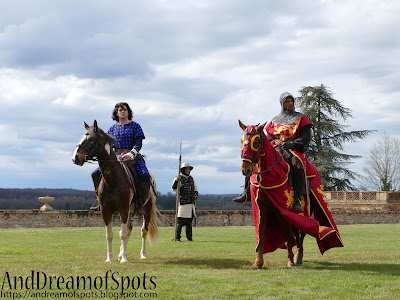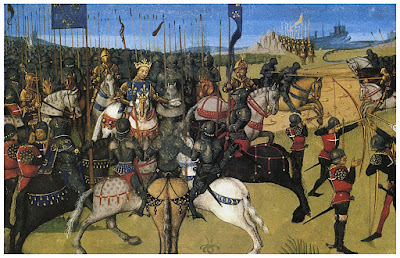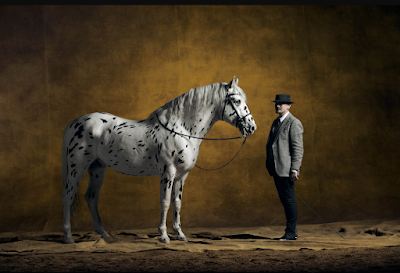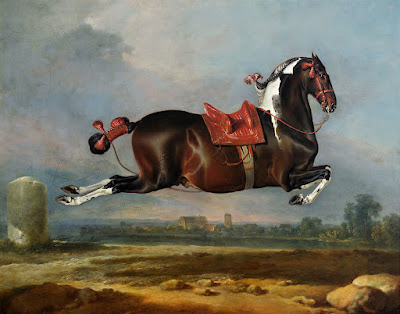*
mardi 25 janvier 2022
mercredi 19 janvier 2022
History Secret - Part Four
After we did the first filming with Excalibur, we got some work to do because the script kind of mention that there will be banners for the next episode with him.
So we did one.
Excalibur was not impressed.
Some other horses were...
It was the case of Quirian, my friend Sabrina horse... wich was supposed to be on the same filming. So he got some banner time too.
Then it was ok for both of them and we were "ready".
*
Next day, we headed back to Digoine Castle with the two stars of the day.
We got costumes for them...
Quirian beeing taller and the most experienced horse got the honor of the horse cover, but both matched together with medieval saddle and most looking historic bridles. They looked just.. dashing!
Before the actors takes their places on horseback, we played a bit in the castle garden. We wanted to be sure none of them will spook with that horse cover flying in the wind, but mostly we wanted to play a bit. That's not everyday that you can ride a medieval horse ;)
As both horses were okay with the gear...
It was time to let them play!
Do you have guessed of wich historic characters they were going to be the charger?
Richard the Lionheart, for Quirian and... Philippe Auguste, King of France for Excalibur.
And now, you want to know if the King of France could have got an appaloosa in medevial time, right?
Maybe this time my answer is a bit more complex than usual...
Middle Age had spotted horse, they were some before and they were some after... So they should have been some in between. But probably less, in regard of the records we have.
It seems that spotted horses lost in popularity during middle age, you can see that because they are barely no spotted horses on medieval paintings and sources...
Though they are some... if you search after it.
But you'll found a spotted horse mostly as the horse of Death (one of the four horsemen of apocalypse). Culture and religion may have pushed the idea that they were a death omen.
And then, have them decline because of popular belief.
But in reality, we don't really know for sure why spotted horse lost their popularity. Probably because fashion and trends comes and goes too.
BUT I managed to found evidence of spotted horse in chevalry...
(c.1445-c.1450 Knights Jousting from Sir Thomas Holme’s Book of Arms)
And even somethin' that looks like one maybe two spotted horses, in a very close reference to Richard the Lionheart, a depiction of... his mother!
So would Philippe Auguste, King of France been riding a spotted horse? Probably not, but there's a really thin chance that yes. In any case my searchs cannot confirm a firm no.
And if you are wonderin' why we choose Excalibur for the role, knowing it wasn't the most historic choice? Well because he was, after Quirian, the best horse we had for such a filming that could have been spooky. We choose a solid minded horse, for the actor safety.
Here's a sculpture of Richard the Lionheart...
And a painting of Philippe Auguste, King of France (the guy in blue on the white horse in the middle of the battle)
Sorry, founding reliable pictures of medieval figures is hard. Most of the time, you only found romantic paintings of those legendary character, like this one... Who depict Richard the Lionheart (on the champagne dilute-like horse) and Philippe Auguste (on the white horse) at St Jean d'Acre during crusades.
*
I've kept that picture for the end, just because I wanted to speak about THAT RIDICULOUS banner in regard of what we expected...
*
Speaking of romantic view of the middle age, guess what? There's a huge presence of spotted horses on them, so here's some. After seeing thoses picture, you would just agree with me that Excalibur isn't such a bad color choice for a romanced history ;)
mardi 18 janvier 2022
How to spot spotted horses for sure in paintings...?
So let's be clear, here's how I determine if I have dapples or spots in front of me ON A PAINTING (this is not an article about genetic, it's about what is drawn in front of me, right?!)
It's a SPOTTED appaloosa horse...
-If the horse have a light base and dark spots.
-If the horse have a dark base but white and/or spotted bump.
-If the horse have a black base but light spots on (snowflake).
-If the horse may have really solid appaloosa vibes like dark color around the bones zone of it's body.
It's a DAPPLE horse if...
-If the horse have a dark base and light spots. Usually base would be grey or brown.
-If the horse have a medium/light base with white spots.
So in my view, that's a dappled horse:
| Johann Georg Von Hamilton (1672-1737): Portrait of a dappled horse from the stud at Eisgrub performing the Levade | ||
So let's define a new spotted color...
It's a spotted PAINT horse...
(With my logic: Spotted "Appaloosa" Horse)
My head explose. I really sees an appaloosa, but I may really want to see one where they are only a roan one. We will never know.
-If it's a dapple grey going white.
(With my logic: Spotted "Appaloosa" Horse)
When I was a child, my father always told me that he loved the fact that for horses, that loves apples, the dapple carryied their own apple. (it works in french too: apple = pomme / dapple = pommelé)
I'm also glad to have found so many historic spotted horses references.
(With my logic: Three Spotted "Appaloosa" Horse / one flaxen chestnut, one dilute (palomino or cream), one "Grey", two Spotted "Paint" horses)



























































































